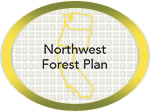Planning Background
The National Forests belong to all of us. Every 15-20 years each National Forest develops a forest plan which considers how to best manage the forest while providing for multiple uses. This video encourages the public to participate in this important process.
Sequoia and Sierra Forest Plan Revisions
The Sequoia and Sierra Forests were two of eight “early adopter” forests across the country, meaning they were the first to revise their land management plans using the 2012 Planning Rule. The forests have released their final environmental impact statement, final forest plans, and signed records of decision. Updated species of conservation concern lists for each forest are also available. See the Sequoia and Sierra Plan Revision website for more information and links to documents.
Modernizing Forest Plans in the Northwest
 The Pacific Northwest and Pacific Southwest regions of the U.S. Department of Agriculture’s Forest Service collaboratively developed and released a Bioregional Assessment of Northwest Forests, which provides a snapshot in time of the current ecological, social and economic conditions on national forest system lands within the Northwest Forest Plan amendment area as well as two adjacent units. The NWFP amended existing forest plans on 19 national forest units across Washington, Oregon and California. The NWFP and those underlying forest plans require key updates to address contemporary management needs. For more information about the process to update forest plans, visit the Modernization of Forest Plans in the Northwest Home Page.
The Pacific Northwest and Pacific Southwest regions of the U.S. Department of Agriculture’s Forest Service collaboratively developed and released a Bioregional Assessment of Northwest Forests, which provides a snapshot in time of the current ecological, social and economic conditions on national forest system lands within the Northwest Forest Plan amendment area as well as two adjacent units. The NWFP amended existing forest plans on 19 national forest units across Washington, Oregon and California. The NWFP and those underlying forest plans require key updates to address contemporary management needs. For more information about the process to update forest plans, visit the Modernization of Forest Plans in the Northwest Home Page.
Northeastern California Plateaus Bioregion Science Synthesis
The Northeastern California Plateaus Science Synthesis compiles the best available science from the past thirty years, and was developed by Rocky Mountain and Pacific Southwest Research Station scientists. The Synthesis reviews over 800 scientific papers on the ecology, status and trends, and socioeconomic issues across this region, comprised of dry pine forests, sagebrush and other unique habitats. Together with two previous science syntheses that cover the Sierra Nevada and Southern Cascades and the Northwest Forest Plan area, the Forest Service and its partners now have available a strong scientific foundation to inform future land management planning and resource management.
Purpose of the Land Management Plan
The Land Management Plan or "Forest Plan" is the principal document that guides the decision making of Forest Service managers. Forest Plans provide long-term management direction for the resources and uses within a national forest.
The National Forest Management Act (NFMA) is the primary statute governing the administration of national forests. It guides the development, amendment, and revision of land management plans to provide for the multiple use and sustained yield of the products and services on National Forest System lands, including outdoor recreation, range, timber, watershed, wildlife and fish, and wilderness (16 U.S.C. 1604(e)). The 2012 planning rule guides this planning using a collaborative and science-based approach to promote the economic, social, and ecological sustainability of national forests and grasslands and other administrative units of the National Forest System. More detailed information about the 2012 planning rule.
The existing forest plans for the Sequoia and Sierra forests are more than 30 years old, dramatically exceeding the 10-15 year duration of plans directed by the National Forest Management Act. Since the forest plans were completed in the late 80s and early 90s, there have been changes in ecological, social, and economic conditions in the area, as well as changes in resource demands, and availability of new scientific information and new policy. These changes necessitate a plan revision to ensure that management direction is responsive to current issues and conditions.
Plan revision addresses the following topics:
- increasing demand for recreation opportunities and their importance in supporting local economies;
- fire and fuels management direction that emphasizes active vegetation management near communities;
- new analyses for timber production opportunities;
- conservation of wildlife and aquatic habitat; and
- new policy and public interest in identifying areas for recommended wilderness and wild and scenic rivers.
You can learn more about local planning activities by viewing the "Planning" section on the website for each Pacific Southwest National Forest. (located under "Managing the Land").

